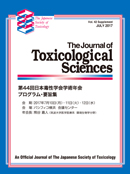The 47th Annual Meeting of the Japanese Society of Toxicology
Displaying 1-50 of 469 articles from this issue
Invited Lecture
-
Session ID: IL
Published: 2020
Released on J-STAGE: September 09, 2020
Download PDF (39K)
Special Lecture
-
Session ID: SL1
Published: 2020
Released on J-STAGE: September 09, 2020
Download PDF (145K) -
Session ID: SL2
Published: 2020
Released on J-STAGE: September 09, 2020
Download PDF (140K) -
Session ID: SL3
Published: 2020
Released on J-STAGE: September 09, 2020
Download PDF (132K) -
Session ID: SL4
Published: 2020
Released on J-STAGE: September 09, 2020
Download PDF (132K) -
Session ID: SL5
Published: 2020
Released on J-STAGE: September 09, 2020
Download PDF (152K)
Educational Lecture
-
Session ID: EL
Published: 2020
Released on J-STAGE: September 09, 2020
Download PDF (150K)
Special Panel Discussion
-
Session ID: PD-1
Published: 2020
Released on J-STAGE: September 09, 2020
Download PDF (143K) -
Session ID: PD-2
Published: 2020
Released on J-STAGE: September 09, 2020
Download PDF (197K) -
Session ID: PD-3
Published: 2020
Released on J-STAGE: September 09, 2020
Download PDF (189K)
Symposium 1
-
Session ID: S1-1
Published: 2020
Released on J-STAGE: September 09, 2020
Download PDF (184K) -
Session ID: S1-2
Published: 2020
Released on J-STAGE: September 09, 2020
Download PDF (165K) -
Session ID: S1-3
Published: 2020
Released on J-STAGE: September 09, 2020
Download PDF (171K) -
Session ID: S1-4
Published: 2020
Released on J-STAGE: September 09, 2020
Download PDF (194K)
Symposium 2
-
Session ID: S2-1
Published: 2020
Released on J-STAGE: September 09, 2020
Download PDF (137K) -
Session ID: S2-3
Published: 2020
Released on J-STAGE: September 09, 2020
Download PDF (149K) -
Session ID: S2-4
Published: 2020
Released on J-STAGE: September 09, 2020
Download PDF (201K)
Symposium 3
-
Session ID: S3-1
Published: 2020
Released on J-STAGE: September 09, 2020
Download PDF (161K) -
Session ID: S3-2
Published: 2020
Released on J-STAGE: September 09, 2020
Download PDF (155K) -
Session ID: S3-3
Published: 2020
Released on J-STAGE: September 09, 2020
Download PDF (118K)
Symposium 4
-
Session ID: S4-1
Published: 2020
Released on J-STAGE: September 09, 2020
Download PDF (133K) -
Session ID: S4-2
Published: 2020
Released on J-STAGE: September 09, 2020
Download PDF (150K) -
Session ID: S4-3
Published: 2020
Released on J-STAGE: September 09, 2020
Download PDF (182K) -
Session ID: S4-4
Published: 2020
Released on J-STAGE: September 09, 2020
Download PDF (189K) -
Session ID: S4-5
Published: 2020
Released on J-STAGE: September 09, 2020
Download PDF (178K)
Symposium 5
-
Session ID: S5-1
Published: 2020
Released on J-STAGE: September 09, 2020
Download PDF (186K) -
Session ID: S5-2
Published: 2020
Released on J-STAGE: September 09, 2020
Download PDF (176K) -
Session ID: S5-3
Published: 2020
Released on J-STAGE: September 09, 2020
Download PDF (154K) -
Session ID: S5-4
Published: 2020
Released on J-STAGE: September 09, 2020
Download PDF (133K)
Symposium 6
-
Session ID: S6-1
Published: 2020
Released on J-STAGE: September 09, 2020
Download PDF (147K) -
Session ID: S6-2
Published: 2020
Released on J-STAGE: September 09, 2020
Download PDF (197K) -
Session ID: S6-3
Published: 2020
Released on J-STAGE: September 09, 2020
Download PDF (160K) -
Session ID: S6-4
Published: 2020
Released on J-STAGE: September 09, 2020
Download PDF (108K) -
Session ID: S6-5
Published: 2020
Released on J-STAGE: September 09, 2020
Download PDF (160K) -
Session ID: S6-6
Published: 2020
Released on J-STAGE: September 09, 2020
Download PDF (137K)
Symposium 7
-
Session ID: S7-1
Published: 2020
Released on J-STAGE: September 09, 2020
Download PDF (164K) -
Session ID: S7-2
Published: 2020
Released on J-STAGE: September 09, 2020
Download PDF (193K) -
Session ID: S7-3
Published: 2020
Released on J-STAGE: September 09, 2020
Download PDF (173K) -
Session ID: S7-4
Published: 2020
Released on J-STAGE: September 09, 2020
Download PDF (146K) -
Session ID: S7-5
Published: 2020
Released on J-STAGE: September 09, 2020
Download PDF (154K)
Symposium 8
-
Session ID: S8-2
Published: 2020
Released on J-STAGE: September 09, 2020
Download PDF (63K) -
Session ID: S8-3
Published: 2020
Released on J-STAGE: September 09, 2020
Download PDF (68K) -
Session ID: S8-4
Published: 2020
Released on J-STAGE: September 09, 2020
Download PDF (67K)
Symposium 9
-
Session ID: S9-1
Published: 2020
Released on J-STAGE: September 09, 2020
Download PDF (140K) -
Session ID: S9-2
Published: 2020
Released on J-STAGE: September 09, 2020
Download PDF (181K) -
Session ID: S9-3
Published: 2020
Released on J-STAGE: September 09, 2020
Download PDF (184K) -
Session ID: S9-4
Published: 2020
Released on J-STAGE: September 09, 2020
Download PDF (213K) -
Session ID: S9-5
Published: 2020
Released on J-STAGE: September 09, 2020
Download PDF (201K)
Symposium 10
-
Evaluation of central nervous system effects of tetrodotoxin by modernization of acute toxicity testSession ID: S10-1
Published: 2020
Released on J-STAGE: September 09, 2020
Download PDF (153K) -
Session ID: S10-2
Published: 2020
Released on J-STAGE: September 09, 2020
Download PDF (157K)
